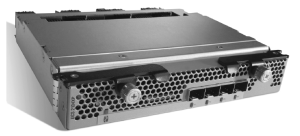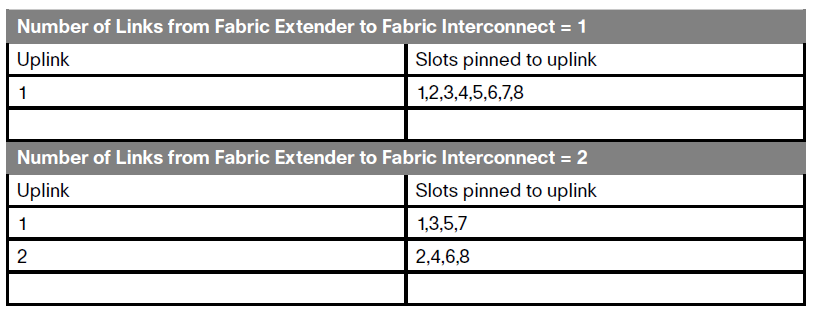The Cisco® UCS 2104XP Fabric Extender is a special blade that plugs in the rear of a UCS 5108 chassis. The UCS 2104XP Fabric Extender has three subsystems inside:
- The Redwood IO_MUX
- The Chassis Management Controller (CMC)
- The Chassis Management Switch (CMS)
Each of these subsystems is designed to perform a specific task in the UCS.
Redwood IO_MUX
The Redwood IO_MUX is used as a bridge between the server blades and the Fabric Interconnect. Redwood is the ASIC that implements the data plane of the Fabric Extender. It provides:
- Eight 10GE external downlink ports to connect the server blades
- Four 10GE external uplink ports to connect to the fabric interconnect
- One 1GE internal port to connect the CMS
- One 100Mbps internal port toward the CMC
By default, mezzanine adapters installed on server blades are pinned to uplinks in a pre-determined fashion. This method makes it easy to understand which blade uses which uplink. Each half-slot supports one adapter. The UCS B200 blade fits into a half-slot and therefore supports a single adapter, but the UCS B250 takes a full-slot and can have two adapters. You can also configure this pinning manually.
The uplink between the FEX and FI uses like in regular topology with FEX the VNTag. VNTag can be used also between the server NIC and FEX downlinks but this requires that servers has adapters that supports VNTag.
Chassis Management Controler
The Chassis Management Controller (CMC) is a processor embedded in the Fabric Extender. The CMC interacts with the UCS Manager and the Cisco Integrated Management Controller (CIMC), aka BMC (Board Management Controller), present on the server blades. The administrator does not interact directly with the CMC, but only through the UCSM. The CMC main function is to provide overall chassis discovery and management and to report the result to the UCS manager.
A baseboard management controller (BMC) is a specialized service processor that monitors the physical state of a computer, network server or other hardware device using sensors and communicating with the system administrator through an independent connection. The BMC is part of the Intelligent Platform Management Interface architecture (IPMI) and is usually contained in the motherboard or main circuit board of the device to be monitored. In fact the BMC is the embedded processor on motherboard -the brain of IPMI.
The Intelligent Platform Management Interface (IPMI) is a set of computer interface specifications for an autonomous computer subsystem that provides management and monitoring capabilities independently of the host system’s CPU, firmware (BIOS or UEFI) and operating system. IPMI defines a set of interfaces used by system administrators for out-of-band management of computer systems and monitoring of their operation. For example, IPMI provides a way to manage a computer that may be powered off or otherwise unresponsive by using a network connection to the hardware rather than to an operating system or login shell.
The CMC implements seven main functions:
- It controls the chassis fans.
- It monitors and logs fan speed.
- It monitors and logs ingress and egress temperatures.
- It controls location indication and chassis fault indications.
- It powers up/powers down power supplies, monitoring and logging voltages, currents, and temperatures inside the chassis.
- It detects presence, insertion, and removal of UCS blades.
- It reads the IDs of the chassis, UCS blades, and Fabric Extenders.
It is important to understand that CMC does not manage UCS blades (UCS does. CMC manage the stuff above in bullets). If two UCS2104XP Fabric Extenders are installed in a chassis, the two CMC processors automatically form a cluster and only one of them will be active at a given time. A high-availability algorithm between the two CMCs defines the active CMC.
Chassis Management Switch (CMS)
The Chassis Management Switch (CMS) provides connectivity to the Cisco Integrated Management Controller (CIMC) present on each server blade. There are eight 100Mbps Ethernet connections and one 1Gb Ethernet connection available in the CMS. Each slot has its own 100Mbps-dedicated Ethernet Interface connected to the blade CIMC. The 1GbE interface is used to connect the CMS to the Redwood IO_MUX. The CMS is an unmanaged switch that requires no configuration.


